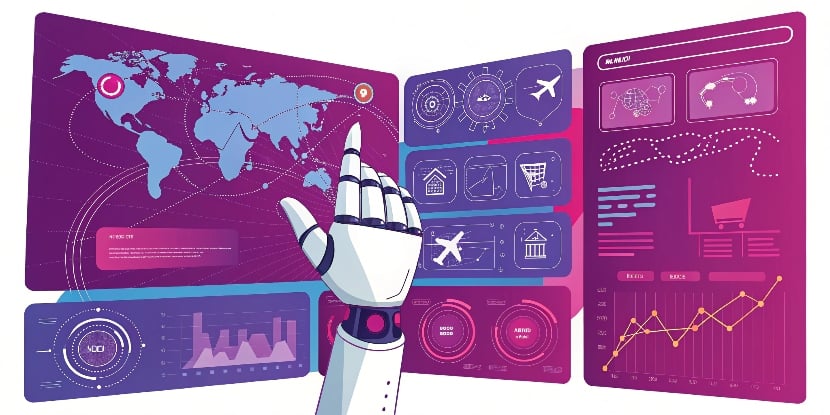Top 5 AI-Powered Cybersecurity Trends for 2025: Proactive Threat Detection, Zero Trust, and More
As we navigate the evolving cyber threat landscape of 2025, artificial intelligence is revolutionizing our digital defenses. In this post, I share my top five AI-powered cybersecurity trends that are set to transform the industry in 2025, from proactive threat detection to enhanced Zero Trust architectures.
1. Proactive Threat Detection Powered by AI
In the past, we often played catch-up with cyberattacks. Today, AI cybersecurity solutions enable us to predict and prevent threats before they materialize. Advanced machine learning algorithms analyze vast amounts of data in real time to detect anomalies and forecast potential breaches.
Key Benefits:
- Predictive Analytics: Establish a baseline for normal activity and flag emerging threats early.
- Continuous Monitoring: Real-time surveillance helps identify vulnerabilities and abnormal network behavior.
- Data-Driven Risk Prioritization: Focus resources on the most critical risks to prevent full-scale attacks.
This proactive threat detection approach is essential for staying resilient in today's dynamic cyber landscape.
2. Automated Incident Response with Adaptive Intelligence
When a breach occurs, every second counts. AI-powered incident response automates time-consuming tasks and provides real-time insights to help contain breaches swiftly. This not only minimizes damage but also helps security teams learn from each incident.
Key Benefits:
- Instant Containment: Automated systems isolate compromised endpoints immediately.
- Rapid Forensics: AI analyzes incident data quickly to trace attack origins.
- Human-AI Collaboration: AI handles routine tasks while security experts focus on complex decisions.
Combining automation with expert oversight ensures that your organization responds faster and more effectively to cyber threats.
3. AI-Enhanced Zero Trust Architecture and Identity Management
The traditional “trust but verify” model has evolved into “never trust, always verify.” AI is at the forefront of enhancing Zero Trust architectures by continuously monitoring and verifying user identities and access.
Key Benefits:
- Continuous Authentication: AI constantly assesses user behavior and context to verify identities.
- Micro-Segmentation: Isolate network segments to prevent lateral movement in case of a breach.
- Dynamic Access Controls: Adjust permissions in real time based on risk analysis.
This dynamic, AI-enhanced Zero Trust model is critical for protecting sensitive data and ensuring secure access in today's hybrid work environments.
4. Defending Against Sophisticated Social Engineering and Shadow AI
Cybercriminals are leveraging AI to craft hyper-personalized phishing attacks that mimic trusted contacts. At the same time, unsanctioned “shadow AI” tools used within organizations pose significant internal risks.
Key Strategies:
- Hyper-Personalized Phishing Detection: Use AI to analyze emails for subtle fraud indicators.
- Governance of Shadow AI: Implement policies and tools to manage unauthorized AI use.
- Deepfake Detection: Leverage advanced algorithms to identify manipulated audio and video content.
By addressing both external social engineering and internal shadow AI risks, we can maintain secure digital communications and protect corporate data.
5. Fortifying Critical Infrastructure with Hybrid AI Strategies
Critical infrastructure—from energy grids to healthcare systems—is a prime target for cyberattacks. AI, when combined with traditional security measures, creates a robust defense strategy that adapts in real time.
Key Benefits:
- Real-Time Adaptive Security: AI adjusts protection measures based on current threat levels.
- Integration with Legacy Systems: A hybrid approach ensures that modern AI defenses work alongside proven conventional methods.
- Enhanced Supply Chain and IoT Security: Secure both primary networks and connected devices to reduce vulnerabilities.
This hybrid strategy is essential for protecting critical infrastructure against sophisticated, evolving cyber threats.
Final Thoughts
In 2025, cybersecurity is a dynamic battlefront where AI-powered tools work hand-in-hand with human expertise to defend against evolving threats. By investing in proactive threat detection, automating incident response, enhancing Zero Trust architectures, countering advanced social engineering, and fortifying critical infrastructure, organizations can build a resilient defense that adapts to the ever-changing threat landscape.
I'm passionate about these trends because I believe embracing AI in cybersecurity is not just an option—it's a necessity. What are your thoughts on these trends? Have you implemented any of these strategies in your organization? Let's continue this conversation in the comments below.
Stay safe, stay vigilant, and let's push the boundaries of what's possible in cybersecurity together.
Ready to Enhance Your Cybersecurity with AI?
Want to learn more about implementing AI-powered cybersecurity solutions in your organization? Explore our blog for deeper insights, or reach out to discuss how we can help develop a tailored cybersecurity strategy that leverages the latest AI technologies.
Related Articles

Introduction to Micro LLMs: The Future of Efficient AI
Explore the breakthrough of micro Large Language Models (LLMs) in AI and NLP. Learn how these compact models balance efficiency and performance, making advanced AI accessible for a wide range of applications.

Manus AI: A New Frontier in Autonomous Intelligence
Explore Manus AI, one of the world's first fully autonomous AI agents. Learn about its capabilities, the technology behind it, and how it's redefining the way we interact with artificial intelligence.